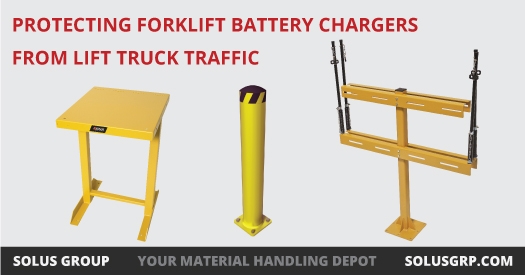We use cookies to make your experience better. To comply with the new e-Privacy directive, we need to ask for your consent to set the cookies. Learn more.
Protecting Forklift Battery Chargers from Lift Truck Traffic
Warehouse managers strive for speed and efficiency when changing and charging forklift batteries, but productivity improvements should always start with protecting forklift battery chargers themselves. Remember that the prevention of forklift collisions does more than protect workers — it also protects expensive equipment. High traffic in and around battery rooms puts chargers at a greater risk for collisions, which can be dangerous and costly.
Additionally, the Occupational Safety and Health Administration requires businesses to protect battery charging equipment. OSHA standard 1910.178(g)(2) addresses the situation briefly, saying "Facilities shall be provided for...protecting charging apparatus from damage by trucks." So, business owners are required to keep their chargers safe, but it's up to individual operations to figure out the best form of protection for their assets.
With that in mind, here are a few ways to greatly reduce the chances of lift truck collisions with chargers and other costly machines in forklift battery handling applications:
1. Use specialized charger stands that increase visibility and secure chargers.
One of the simplest solutions for protecting charging equipment is to install wall-mounted chargers or durable, elevated charger stands. Heavy-duty battery stands help elevate chargers to a safer, more visible level, while keeping them out of aisles. An "OSHA safety yellow" powder coating resists electrolyte and adds even more visibility for forklift operators.
Forklift Battery Charger Stands from Solus Group are available in multiple sizes and configurations to fit the unique needs of individual battery rooms. Dual and Quad Charger Stand Kits elevate and secure wall-mounted chargers, while Charger Wall Brackets hold chargers at a safe height along a wall.

2. Install bollards or barriers around chargers for added protection.
A dependable way to keep lift truck traffic within safe lanes is to install Structural Barrier Rails or strategically placed Structural Bollards around the battery charging area. These bright “OSHA safety yellow” barriers can easily stop a forklift in its tracks before a more damaging collision occurs.
Structural Barrier Rails from Solus Group have a 10,000-pound impact rating at 4 mph and are installed with a simple drop-in/lift-out system that allows for easy removal. Using them around expensive equipment protects investments and ensures compliance with OSHA 1910.178(g)(2).
3. Educate staff on proper forklift operation.
OSHA provides a detailed list of best practices for forklift operation. In a perfect world, all lift truck operators would follow these recommendations. Unfortunately, the fast pace of warehouses can occasionally result in an operator or two cutting corners (sometimes literally) and making mistakes.
Those mistakes can result in big damages and serious injuries. Insisting on safe forklift operation helps keep staff and equipment safe. The combination of good education and consistent oversight can do wonders for reducing accidents in a battery room.
There's no magic bullet to preventing forklift collisions with charging equipment.
There's no one single remedy, but thousands of operations successfully protect their costly equipment and valued staff every day. The facilities that get the most value out of investments in forklift battery chargers are bound to follow a few — or, more likely, all — of the above suggestions
"29 CFR 1910.178. - Powered industrial trucks." OSHA. Occupational Safety & Health Administration, United States Department of Labor, n.d. Web. 2 Nov. 2017.
“Operating the Forklift: Traveling & Maneuvering.” OSHA. Occupational Safety & Health Administration, United States Department of Labor, n.d. Web. 2 Nov. 2017.
